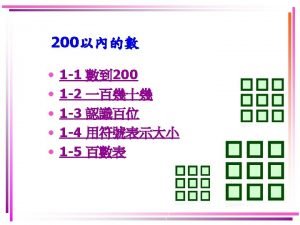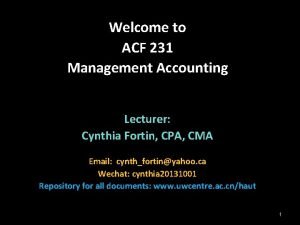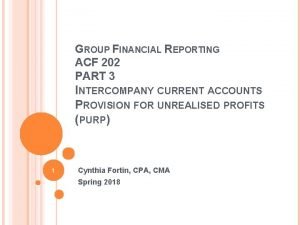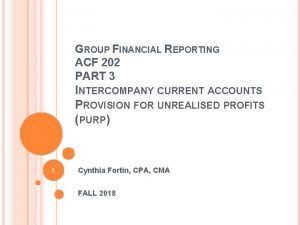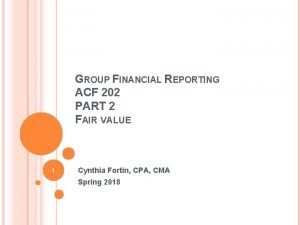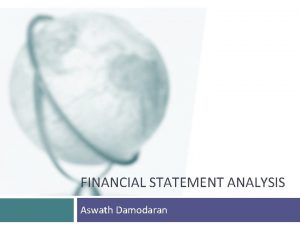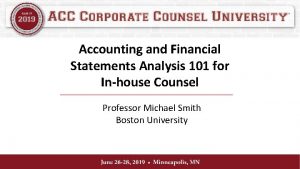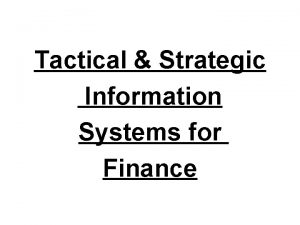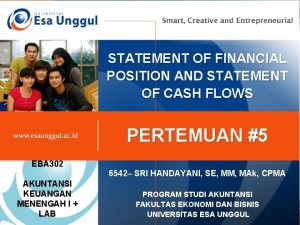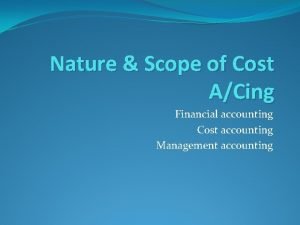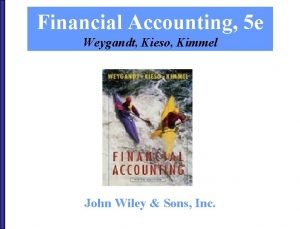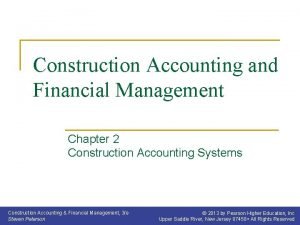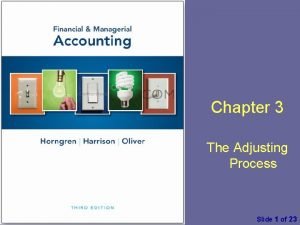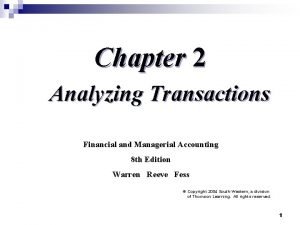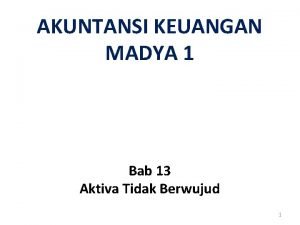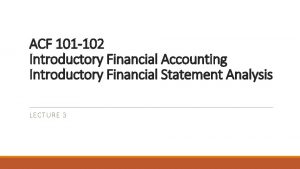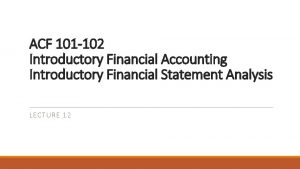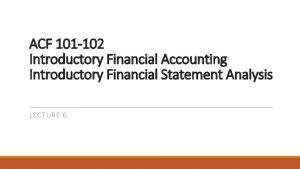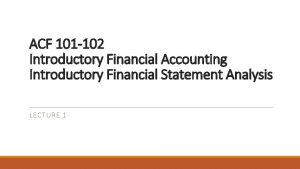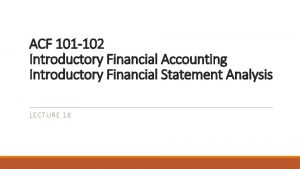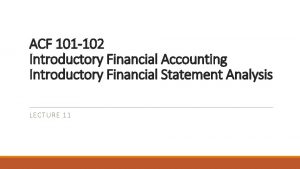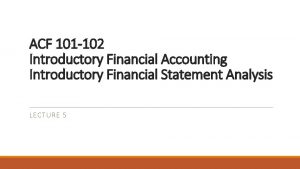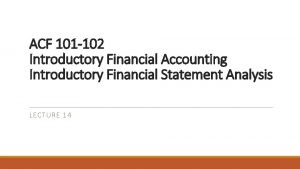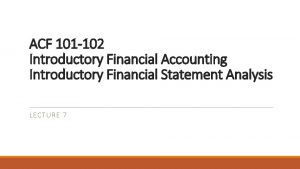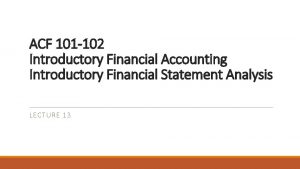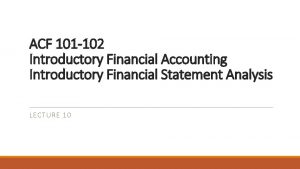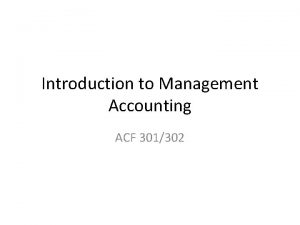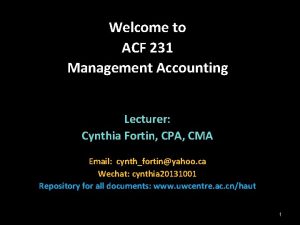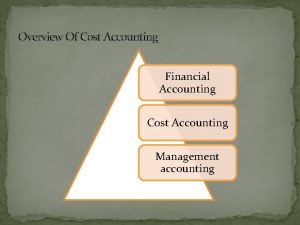ACF 101 102 Introductory Financial Accounting Introductory Financial



































- Slides: 35

ACF 101 -102 Introductory Financial Accounting Introductory Financial Statement Analysis LECTURE 16

Learning Outcome Describe the uses and purposes of Financial statements for analysis of firms. Understand the usage of external financial reports. Appraise financial performance and the position of an organisation through the calculation and review of a number of basic ratios and various methods of analysis.

Topics Financial Statement Analysis Ratio Analysis

Information Sources Company annual reports include: ◦ Narrative information about the company ◦ Management’s discussion and analysis (MD&A) ◦ The auditor’s report ◦ Management’s report on its responsibility for the financial statements and internal controls ◦ The financial statements ◦ Footnotes to the financial statements which include a summary of the accounting principles used ◦ Comparative financial data for a number of years 4 of 46

Information Sources Securities and Exchange Commission (SEC) ◦ Form 10 -K (annual report with audited statements) ◦ Form 10 -Q (quarterly report – statements not audited) ◦ Form 8 -K (unscheduled material events) ◦ Other events on specialized forms Other sources of information: ◦ Company press releases and websites ◦ Outsiders such as 1) the general financial press, 2) trade and industry publications, 3) analysts’ research 5 of 46

Information Sources Why analyze financial statements? ◦ All ◦ Will the company be in business beyond one year ◦ What are the risks of not achieving what is sought ◦ Investor - Predict returns (dividends/earnings) since they influence their investment’s market value ◦ Creditors - Predict returns (principal, interest on time) ◦ Short-term liquidity - meet current payments ◦ Long-term solvency – pay off maturing debt ◦ Others (creditors, labor unions, governments, etc. ) 6 of 46

Information Sources Caveats to analysis ◦ It is assumed the past is a good predictor of the future ◦ Comparing your ratios to other companies’ ratios requires ◦ Both to make financial data available to the public ◦ GAAP is used consistently ◦ Other financial statements use the same GAAP ◦ Ratios were computed using the same formula (only EPS has a single agreed upon definition) ◦ Major one-time events are factored out of ratios ◦ Different conclusions can be drawn from similar data 7 of 46

Analysis Trend analysis – computes percentage change in similar accounts between years Percentage change = This year less last year x 100 Last year ◦ Why does this trend/pattern exist? ◦ Is it favorable or unfavorable? ◦ Will it continue? Problems – some trends are meaningless ◦ Similar data exists for only one of the two years ◦ Amount is positive one year; next year it is negative ◦ One time events bias one of the two years 8 of 46

Analysis • Trend Analysis - continued 9 of 46

Analysis Trend Analysis – continued ◦ 10 of 46 Example: Percentage change in revenue 2009 2. 9% 2008 2. 8% 2007 2. 4% 2006 2. 2% 2005 2. 0% Conclusions?

Analysis Trend Analysis – continued ◦ Managements’ Discussion and Analysis (MD&A) includes disclosures about ◦ Capital resources and liquidity ◦ Results of operations (including sales and expenses) ◦ Contractual obligations and commitments ◦ Critical accounting estimates ◦ Adoption of new accounting policies 11 of 46

Analysis Trend Analysis – continued ◦ Compound annual growth rate (CAGR) takes multi-year changes and reduces them to a compound annual rate 1/4 years 2009 Sales Revenue = 19, 176 2005 Sales Revenue = 13, 739 (Requires usage of Future Value of $1 table (Ch. 9)) 12 of 46 – 1= 8. 69%

Analysis Common-size statements – compare each account/total (component) on a financial statement to one other number on that statement and express each component as a percentage to that one number ◦ Balance Sheet: Total Assets = 100% ◦ Cash = 12% of total assets ◦ Income statement: Revenue = 100% ◦ Wage expense = 7% of total revenue 13 of 46

Analysis Common-Size Income Statement 14 of 46

Analysis • Common Size Balance Sheet 15 of 46

Analysis Segment Reporting ◦ Companies organize themselves according to various operating segments such as product line, geographical location, customer, etc. ◦ Segment performance, balances, etc. , cannot be identified in the consolidated statements ◦ Therefore companies must report information about each segment in the statements’ footnotes ◦ Segment information includes information on sales, profits, and assets 16 of 46

Analysis • Segment Reporting - continued 17 of 46

Basic Financial Ratios Ratio Usage ◦ External users – invest, lend, and other decisions ◦ Internal users ◦ Rewards for achieving target ratio levels, i. e. , insiders can affect a ratio that impacts their wealth ◦ Reason why firms have modified their incentives ◦ Must look at multiple ratios – one ratio does not tell the whole story. Ratio changes alert investors to good and bad See earlier lessons and text for ratio calculations 18 of 46

Basic Financial Ratios Time Series Bench Mark Cross Sectional One company’s data over time Generally accepted standard levels 1 Others in same industry 1 2 Short-term liquidity Current, Quick, Receivables Turnover, Average collection period, Inventory Turnover, Average days in Inventory Long-term solvency Debt to Assets, Debt to Equity, Interest Coverage Profitability Market price and dividends Return on Common Equity, Gross Profit Percent, Total Asset Turnover, EBIT to Sales, Return on Assets, Earning per Share Price-Earnings, Book Value per Share of Common Stock, Dividend Yield, Dividend Payout 1. For some companies in multiple business (General Electric, Berkshire Hathaway), ratios do not lend themselves to comparisons. 2. See Dun and Bradstreet, Standard and Poor’s, etc. 19 of 46

Basic Financial Ratios 20 of 46

Basic Financial Ratios 21 of 46

Evaluating Corporate Performance Operating Performance - daily activities that generate something Performance = What achieved What produced those achievements Miles per Gallon ◦ ◦ 22 of 46 = 35 miles 1 gallon of gas Performance – Between the beginning and end of the measurement period “Produced” – sometimes must average beginning and ending amounts to determine the average of what was available to produce the achievements.

Evaluating Corporate Performance Operating Performance - daily activities that generate revenues and expenses Performance Return on Investment = What achieved What produced them. Return on Equity (ROE) = Net Income Invested Capital and Debt = Net Income Average total Equity Return on Common = Net Income – Pfd. Dividends Stockholders’ Equity Average Common Equity 23 of 46

Evaluating Corporate Performance Operating Performance - daily activities that generate revenues and expenses Performance = What achieved What produced them Return on Earnings before interest and taxes. Assets (ROA) = (EBIT) (before tax) Average Total Assets ROA (after tax) 24 of 46 = Net Income (after tax) + (Interest Expense x (1 – tax rate) Average Total Assets

Operating Performance These ratios for Nike Inc. are: EBIT to Sales Ratio 10. 4% $1, 996. 7 Sales $19, 176. 1 ROA 15. 5% Sales $19, 176. 1 Total Asset Turnover 1. 493 Times Average Total Assets $12, 846. 2 25 of 46

Evaluating Corporate Performance Financing Decisions - where the company gets cash and how it uses cash to its benefit ◦ Capitalization (capital structure) refers to long-term debt and equity ◦ How much should equity be versus debt? . ◦ How much should be short and long-term debt? ◦ Can debt be used to enhance the rate of return to common stockholders? ◦ Leverage Mean the same thing ◦ Financial leverage ◦ Trading on the equity 26 of 46

Evaluating Corporate Performance Financing Decisions – Leverage example Firm A Firm B Firm C $80, 000 0 $30, 000 $60, 000 $80, 000 $50, 000 $20, 000 20% 20% Year 2 10% 10% Year 3 5% 5% 5% 0% 10% 20% Assets Liabilities Equity ROA Year 1 Interest rate on debt 27 of 46

Evaluating Corporate Performance Financing Decisions – Leverage example 28 of 46

Evaluating Corporate Performance Financing Decisions – Leverage example ◦Favorable ROE > ROA > Average cost of debt ◦Unfavorable Average cost of Debt > ROA > ROE ◦No impact ROE = ROA 29 of 46

Evaluating Corporate Performance Economic Value Added ◦ Residual wealth of company after deducting the cost of its capital from operating profit ◦ Firm has debt and equity (capital) = $100, 000. ◦ Cost of capital = $100, 000 x 10% = $10, 000 ◦ Interest have to pay on debt ◦ Stockholder returns (dividends and appreciation) ◦ 30 of 46 Operating profit after tax $12, 000 Cost of capital (10, 000) Value added $2, 000 Positive = adding value; Negative = loosing value

Evaluating Corporate Performance Economic Value Added - continued ◦ Cost of capital is a weighted average ◦ An internal management tool to help allocate and manage scarce capital resources such as equipment and real estate ◦ Can adjust components, e. g. operating profit ◦ R&D is expensed ◦ Some feel it has value and should be amortized ◦ Add back R&D expense then subtract amount amortizable to arrive at a revised operating profit 31 of 46

Earnings Per Share General Formula Net Income – Preferred Dividends Weighted Average # shares of Common Stock Outstanding ◦ Only ratio to have a uniform definition (FASB) and be required on a financial statement (Income Statement) ◦ Key ratio that drives changes a share’s market value Preferred Stock/Dividends ◦ Convertible to common and nonconvertible ◦ Reduce numerator by the amount due to nonconvertible preferred stockholders 32 of 46

Earnings Per Share Weighted Average ◦ 750, 000 common shares were outstanding at the beginning of the year and 200, 000 additional common shares were issued 3 months before the year-end. 750, 000 x 9/12 = 562, 500 750, 000 + 200, 000 = 950, 000 x 3/12 = 237, 500 Weighted average shares = 800, 000 ◦ The denominator must also be adjusted retroactively for any stock splits and stock dividends 33 of 46

Earnings Per Share Outstanding ◦ Authorized – shares per the corporate charter ◦ Issued – shares sold to the public ◦ Outstanding - Issued less any repurchased (treasury stock, i. e. , in the hands of stockholders) Earning per Share ◦ Basic - Per outstanding shares before exercising options or conversion rights ◦ Diluted - Per outstanding and potentially outstanding shares after exercising options or conversion rights 34 of 46

Earnings Per Share Net Income – Preferred Dividends Weighted Average # shares of Common Stock Outstanding Net income - $10, 500, 000 Nonconvertible Preferred dividend - $500, 000 Weighted average common outstanding - 800, 000 shares Convertible preferred (existed the entire year) - 200, 000 shares Basic $10, 500, 000 – $500, 000 = $12. 50 per share $800, 000 Diluted $10, 500, 000 – $500, 000 = $10. 00 per share $800, 000 + $200, 000 35 of 46
 100 101 102
100 101 102 Prime numbers between 1 and 100
Prime numbers between 1 and 100 Intermediate accounting chapter 1
Intermediate accounting chapter 1 Social accounting ppt
Social accounting ppt Acf 231
Acf 231 Nt39538h-c1272b cof data
Nt39538h-c1272b cof data Army cadets values and standards
Army cadets values and standards Acf certification
Acf certification Army cadet force syllabus
Army cadet force syllabus Biotite
Biotite Aws academy cloud foundations (acf)
Aws academy cloud foundations (acf) Provision of unrealised profit
Provision of unrealised profit Acf 202
Acf 202 Acf 202
Acf 202 Portal acf
Portal acf Sony acf
Sony acf Acf formula
Acf formula Aswath damodaran accounting
Aswath damodaran accounting Finance topics for discussion
Finance topics for discussion Inhouse financial statement
Inhouse financial statement Aasb 101 presentation of financial statements
Aasb 101 presentation of financial statements Benefits of computerized accounting
Benefits of computerized accounting Conservatism accounting principle
Conservatism accounting principle Tactical accounting
Tactical accounting Cash debt coverage
Cash debt coverage Scop of management accounting
Scop of management accounting Nature and scope of cost accounting
Nature and scope of cost accounting Scope of accounting
Scope of accounting Kimmel accounting tools 5e
Kimmel accounting tools 5e Construction accounting and financial management
Construction accounting and financial management Income statement in financial accounting
Income statement in financial accounting Financial accounting chapter 2 solutions
Financial accounting chapter 2 solutions Unit 5 lesson 2 financial accounting
Unit 5 lesson 2 financial accounting Unit 5 lesson 2 financial accountings
Unit 5 lesson 2 financial accountings Financial accounting chapter 13
Financial accounting chapter 13 Equity accounted investments
Equity accounted investments
